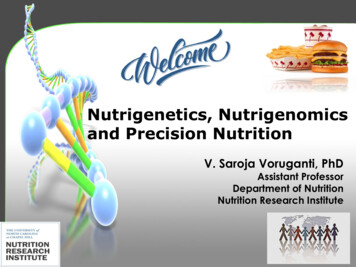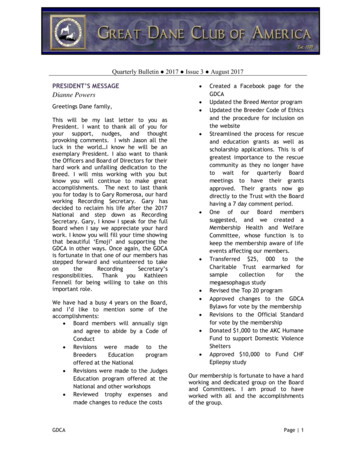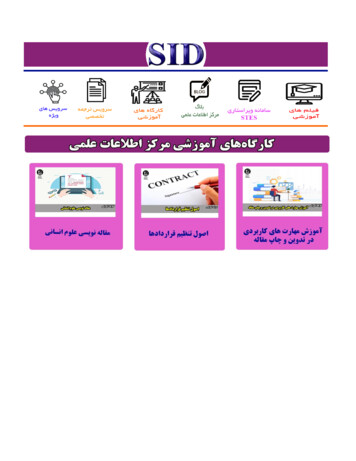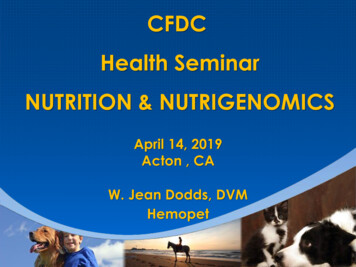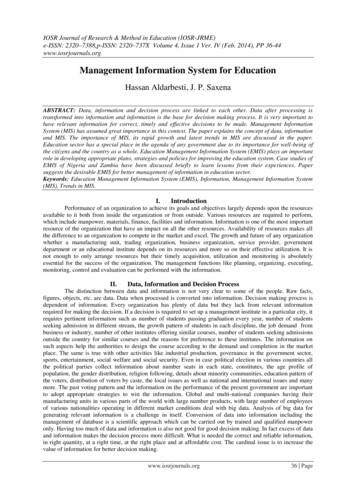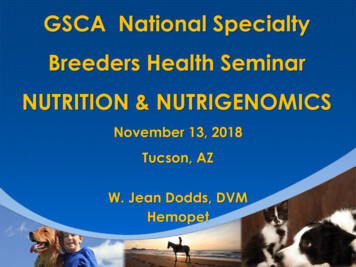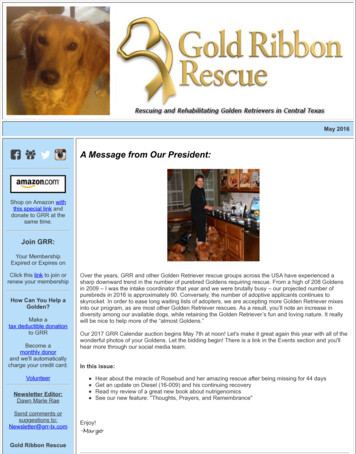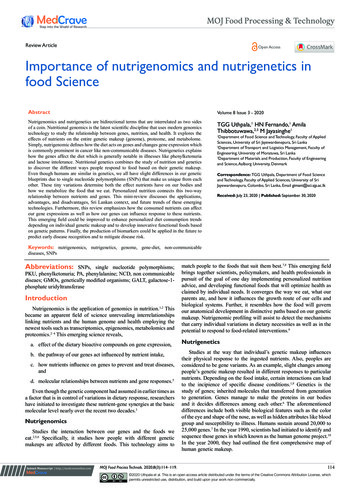
Transcription
MOJ Food Processing & TechnologyReview ArticleOpen AccessImportance of nutrigenomics and nutrigenetics infood ScienceAbstractVolume 8 Issue 3 - 2020Nutrigenomics and nutrigenetics are bidirectional terms that are interrelated as two sidesof a coin. Nutritional genomics is the latest scientific discipline that uses modern genomicstechnology to study the relationship between genes, nutrition, and health. It explores theeffects of nutrients on the entire genetic makeup (genome), proteome, and metabolome.Simply, nutrigenomic defines how the diet acts on genes and changes gene expression whichis commonly prominent in cancer like non-communicable diseases. Nutrigenetics explainshow the genes affect the diet which is generally notable in illnesses like phenylketonuriaand lactose intolerance. Nutritional genetics combines the study of nutrition and geneticsto discover the different ways people respond to food based on their genetic makeup.Even though humans are similar in genetics, we all have slight differences in our geneticblueprints due to single nucleotide polymorphisms (SNPs) that make us unique from eachother. These tiny variations determine both the effect nutrients have on our bodies andhow we metabolize the food that we eat. Personalized nutrition connects this two-wayrelationship between nutrients and genes. This mini-review discusses the applications,advantages, and disadvantages, Sri Lankan context, and future trends of these emergingtechnologies. Furthermore, this review emphasizes how the consumed nutrients can affectour gene expressions as well as how our genes can influence response to these nutrients.This emerging field could be improved to enhance personalized diet consumption trendsdepending on individual genetic makeup and to develop innovative functional foods basedon genetic patterns. Finally, the production of biomarkers could be applied in the future topredict early disease recognition and to mitigate disease risk.TGG Uthpala,1 HN Fernando,1 AmilaThibbotuwawa,2,3 M Jayasinghe1Department of Food Science and Technology, Faculty of AppliedSciences, University of Sri Jayewardenepura, Sri Lanka2Department of Transport and Logistics Management, Faculty ofEngineering, University of Moratuwa, Sri Lanka3Department of Materials and Production, Faculty of Engineeringand Science, Aalborg University, Denmark1Correspondence: TGG Uthpala, Department of Food Scienceand Technology, Faculty of Applied Sciences, University of SriJayewardenepura, Colombo, Sri Lanka, EmailReceived: July 23, 2020 Published: September 30, 2020Keywords: nutrigenomics, nutrigenetics, genome, gene-diet, non-communicablediseases, SNPsAbbreviations:SNPs, single nucleotide polymorphisms;PKU, phenylketonuria; PA, phenylalanine; NCD, non communicablediseaes; GMOs, genetically modified organisms; GALT, galactose‐1‐phosphate uridyltransferaseIntroductionNutrigenomics is the application of genomics in nutrition.1,2 Thisbecame an apparent field of science unrevealing interrelationshipslinking nutrients and the human genome and health employing thenewest tools such as transcriptomics, epigenomics, metabolomics andproteomics.2–4 This emerging science reveals,match people to the foods that suit them best.7,8 This emerging fieldbrings together scientists, policymakers, and health professionals inpursuit of the goal of one day implementing personalized nutritionadvice, and developing functional foods that will optimize health asclaimed by individual needs. It converges the way we eat, what ourparents ate, and how it influences the growth route of our cells andbiological systems. Further, it resembles how the food will governour anatomical development in distinctive paths based on our geneticmakeup. Nutrigenomic profiling will assist to detect the mechanismsthat carry individual variations in dietary necessities as well as in thepotential to respond to food-related interventions.9a. effect of the dietary bioactive compounds on gene expression,Nutrigeneticsb. the pathway of our genes act influenced by nutrient intake,Studies at the way that individual’s genetic makeup influencestheir physical response to the ingested nutrients. Also, peoples areconsidered to be gene variants. As an example, slight changes amongpeople’s genetic makeup resulted in different responses to particularnutrients. Depending on the food intake, certain interactions can leadto the incipience of specific disease conditions.1,9 Genetics is thestudy of genes; inherited molecules that transferred from generationto generation. Genes manage to make the proteins in our bodiesand it decides differences among each other.6 The aforementioneddifferences include both visible biological features such as the colorof the eye and shape of the nose, as well as hidden attributes like bloodgroup and susceptibility to illness. Humans sustain around 20,000 to25,000 genes.7 In the year 1990, scientists had initiated to identify andsequence those genes in which known as the human genome project.10In the year 2000, they had outlined the first comprehensive map ofhuman genetic makeup.c. how nutrients influence on genes to prevent and treat diseases,andd. molecular relationships between nutrients and gene responses.5Even though the genetic component had assumed in earlier times asa factor that is in control of variations in dietary response, researchershave initiated to investigate these nutrient-gene synergies at the basicmolecular level nearly over the recent two decades.3NutrigenomicsStudies the interaction between our genes and the foods weeat.2,5,6 Specifically, it studies how people with different geneticmakeups are affected by different foods. This technology aims toSubmit Manuscript http://medcraveonline.comMOJ Food Process Technols. 2020;8(3):114‒119.114 2020 Uthpala et al. This is an open access article distributed under the terms of the Creative Commons Attribution License, whichpermits unrestricted use, distribution, and build upon your work non-commercially.
Importance of nutrigenomics and nutrigenetics in food ScienceNutrigenetics enables us to realize how our genes affect themethod we react to foods, beverages, and supplements. This analyseshow genetic makeup or variations of individuals affect their responseto diet. It has long been visible that certain people react differentlyfrom others to particular foods. For instance, people with lactoseintolerance undergo gastrointestinal uneasiness after ingestioncertain dairy products, while other people can consume dairy withoutdifficulties. The individuals who cannot digest the natural sugarspresent in milk products are called lactose intolerance patients.8,9The gene which is responsible for making lactase is switched off inlactose intolerance individuals.9 As a result, abdominal pain, bloating,diarrhea, and nausea-like conditions can occur.9 The individualswho suffer from Phenylketonuria (PKU) do not have phenylalaninehydroxylase for breaking down phenylalanine (PA) which is presentin food products.10,11 PA is usually converted to tyrosine in a healthyperson’s body. But in PKU individuals, it is metabolized into phenylpyruvic acid.10 If high level of this acid is accumulated up in the body,it can commence to disordered brain functions and in severe cases inmental retardation and seizure.11The ultimate goal of nutrigenetics is to provide nutritionalrecommendations for individuals according to their genetic makeup.8There are important factors to be considered regarding nutritionalgenomics. The first is to recognize diet as a significant risk factor forcertain diseases in some individuals.2 Additionally, ordinary dietarynutrients can act on the human genome, either directly or indirectlyto change gene expression or structure.1,4,9 Nevertheless, the extentCopyright: 2020 Uthpala et al.115to which diet affects the balance between healthy and diseasecircumstances may depend on an individual’s genetic makeup.Further, most diet governed genes are expected to perform a task inthe onset, progression, and acuteness of chronic diseases. Therefore“personalized nutrition” can be used to prevent, mitigate or curechronic diseases.The concepts of nutrigenomics andnutrigeneticsGenetics is a critical concern of every individual fitness puzzle.Nutrigenomics is an emerging science and technology field thatreveals interrelationships (Figure 1) linked to nutrients and the humangenome based on modern tools such as transcriptomics, metabolomics,epigenomics, and proteomics.4 The genome information has advancedapproaches in analyzing the role of genetic variation to explainpersonal differences related to nutrition, underlying in part thesensitivity for nutrition-related disorders.1,8 As shown in the Figure 1,the basic analytical tools of the “omics” revolution in nutrition scienceare genomics, transcriptomics, proteomics, and metabolomics.4,9 TheGreek suffix “ome” defines “complete” or “all” and it has been usedwith general terms of genes, proteins, etc.10 Therefore comprehensiveanalysis of DNA structure and function is done by genomics while,transcriptomics determines patterns of gene expressions. The studyof protein synthesis, structures, and patterns of protein expression iscovered by proteomics while the analysis of the metabolite profile andfunction is explained by metabolomics.Figure 1 The interrelation of how food intake contributes to phenotype.Interaction of nutrients and gene expressionNutrigenomicsdiet consumption proceeded in signal transduction pathways C as shownin Figure 2.Nutrients can act on our genes and can change the genetic expression/phenotype by following pathways as shown in the diagram (Figure 2). Asshown in path A, nutrients act as a ligand for transcription factor receptorsand affect normal cell growth. Also, diet can influence gene expressionby metabolism as depicted in pathway B. These influences can be doneeither primary or secondary pathways by altering concentrations ofsubstrates or intermediates.9 Further, normal cell growth can be altered byResearchers have revealed the interrelation of live cells responseto varying environments with modified gene expressions. And alsothey have studied how nutrition can affect the proliferation anddifferentiation of cells.1,10–13 Beside metabolome and proteomestudies, the transcriptome or genome analysis is becoming morerequired. Therefore nutrigenomic studies on basic and appliednutrition in food research furnishes new insights into the influencesCitation: Uthpala TGG, Fernando HN, Thibbotuwawa A, et al. Importance of nutrigenomics and nutrigenetics in food Science. MOJ Food Process Technols.2020;8(3):114‒119. DOI: 10.15406/mojfpt.2020.08.00250
Copyright: 2020 Uthpala et al.Importance of nutrigenomics and nutrigenetics in food Scienceto food ingredients such as carbohydrates, proteins, fats, carotenoids,vitamins, minerals, flavonoids, and edible phytochemicals at themolecular level.11,12 Further nutrigenomic applied areas include foodsafety, food authenticity, researches in genetically modified organisms(GMOs), and personal food planning.13116Table 1 shows how certain nutrients can regulate the gene andinfluence our genetic expression in order to prevent or suppressNCDs like cancers, obesity etc. In diseases like cancers, DNAmethilation process is take place which have strong impact on thegenetic expression. Pufulete and others have found that DNA hypomethylation can be reversed by intakes of folic acid.13–20 Aimingdelayed or inhibited apoptosis is a huge advance in cancer medicationand an extremely emerging area of experimentation. Flavonoids haveobtained attention as cancer-preventing agents and have conferredhigh capability as cell toxic anti-cancer drugs supporting apoptosis incarcinoma cells. Also, studies have found that kaempferol, which fallsunder flavonoids can induce DNA fragmentation and upregulation ofp53 expression and phosphorylation commences to disrupting cellproliferative signaling in breast cancer cells.21,22 Theaflavins are themajor bioactive polyphenols in tea.21–24 Rheumatoid arthritis is aninflammatory joint dysfunction, whose change leads to the destructionof cartilage and bone. Researches have revealed that Theaflavins as apotential ingredient for the prevention of cartilage degeneration. Alsothe Mediterranean diet has investigated as a cardio protective dietwhich is rich in monounsaturated and omega-3 polyunsaturated fats,vegetables, fruits, grains and nuts.25Nutrients works as gene switchesFigure 2 Different pathways of how nutrients act on gene expression innormal cells.Researchers have experimented the effect on nutrient intake dueto prevalence gene expression and disease using rat models and cellculture studies.26,27 Certain diseases rising in regularity are connectedwith altered DNA methylation. DNA methylation is achieved byconversion of foods that are rich in methyl donors (folate, vitamin B12,methionine, betaine and choline available foods such as garlic, beets,and onions) into energy.28 Mice carry a gene named agouti (gene madethem yellow instead of brown) cause them to be hungrier and obese.The presence of this gene made them susceptive to complicationssuch as diabetes and cancer etc.29,30Table 1 The relationship of how nutrients impact on the genes and diseasesNutrientGene impactRelated diseaseReferenceFolic acidDNA methylationCancer13,14Fatty acidsBind to transcription factorsObesity15Vitamin DmRNA stabilityKidney disease16–18Vitamin ERadiation mimic (DNA oxidation)Cancer, heart disease, immune dysfunction19,20TheaflavinsDecrease mRNA syntheesisArthritis21,22FlavonesIncrease mRNA synthesisinduce DNA fragmentationCancer23,24NiacinDisables DNA repair (poly ADP ribose)Neurological symptoms (memory loss)19,20Agouti mice are genetically identical. Scientists have proven thatthe differences result from variations in the expression of the agoutigene and coat color appearance can be controlled by changing themother’s diet (food supplements rich in methyl donors) before,during, and after pregnancy.29,31 The nutrient substances (chemical)connected to the agouti genes in the developing baby agouti micecan act as a chemical switch toward the genes (Figure 3). The genesand DNA coding were yet there, but gene expression has turned off.The baby mice were born brown had normal appetites and lived longdisease-free survivals.29,32Genetic variation and personalized diets- NutrigeneticsNutrigenetics studies how the way individuals’ genetic makeupinfluences their physiological response to the nutrients they consume.It considered that people are gene variants. As proof, the differencesbetween people’s genetic makeup cause various reactions to particularnutrients and these interactions can encounter specific disease states.33As mentioned in the introduction section PKU, lactose intoleranceand galactosemia are common consequences of nutrigenetics.34,35PKU is a limited inborn syndrome caused by a mutation in a particularCitation: Uthpala TGG, Fernando HN, Thibbotuwawa A, et al. Importance of nutrigenomics and nutrigenetics in food Science. MOJ Food Process Technols.2020;8(3):114‒119. DOI: 10.15406/mojfpt.2020.08.00250
Copyright: 2020 Uthpala et al.Importance of nutrigenomics and nutrigenetics in food Sciencegene that encodes for the enzyme phenylalanine hydroxylase.8,10Galactosemia is resulted from a limited recessive attribute ingalactose‐1‐phosphate uridyltransferase (GALT), commencing tothe collection of galactose in the blood and raising the risk of mentalretardation.10,36 Phenylalanine‐restricted and galactose‐free, tyrosinesupplemented diets are recommended to consume later mentionedmonogenic diseases, respectively.10,37 Therefore, nutrigenetics is animportant analyses of how the genetic variations in individuals couldaffect their response to diet.Figure 3 The mouse on the left’s mother had fed with a normal mouse dietand the mouse on the right’s mother had fed a food diet rich in methyl donors.The left mouse became yellow and obese, while the right moue becamebrown and healthy.Genetic variations among populationAll humans are 99.9% identical at gene sequence level. Butcommon polymorphisms can determine the dietary requirement ofeach individual. Generally, 0.1% variations in sequence producedifferences in phenotype.8 This variations manipulate individualsrespond differently even with food consumption. Most commontype of polymorphisms is single nucleotide polymorphism which iscalled as SNP.38,39 A SNP is sequence variation occurred in a DNA byreplacing a single nucleotide (adenine (A) or thymine (T) or cytosine(C) or guanine (G)) in the genome among members of a species orpaired chromosomes in an individual (Figure 4). SNPs change atsingle base makes 90% of all variations and about 3 million SNPsare identified in humans. These differ SNPs in an individual canlead unique response to same diet among group of people.40,41 Otherthan above variations, structural variations (deletions, inversions,insertions, duplications, and copy-number variations) in chromosomeand clines can be observed rarely in organisms that can influencesnutrient metabolism pathways.39,42,43117intakes can be assessed comprehensively by the above technologies.Some of these technologies are still in their initial stage whilst othersare advanced and accordingly differ in their research-level concerninghealth issues.Chronic diseases and various cancer types can be prevented or atleast limited by the ingestion of balance and sensible nutrition.44,45The awareness gained from examining the diet or gene synergiesin distinctive populations may provide knowledge that is demandedto approach the significant global issues like malnutrition. Alsogenetic diversity is associated to influence absorption, metabolism,consumption, utilization and elimination of nutrients and foodbioactive, which ultimately affects several metabolic pathways.46Therefore providing personalized nutrition advice that will optimizehealth according to individual requirments are in demand.8,47 Furtherthese technologies and findings could be implimented to improve theperformance of athletes designing personalied nutition plans.48Also gluten free diets for celiac diseases and pro-biotics for lactoseintolerance individuals have been developed in the food industryas a result of nutrigenetics.49 Further, phenylalanine‐restrictedand galactose‐free, tyrosine supplemented diets are innovated toPKU patients and galactosemia patients respectively. Accordingly,these emerging nutrigenetic and nutrigenomic technologies areapplied in novel food technology product developments. Speciallyresearch studies are carried out in the functional and medical foodapplications42,46,50,51 to develop nutraceuticals and pharmaceuticals.Additionally new researches are carried on to study the complexmetabolic pathways which are involved in multiple SNPs. Moreover,genomic medicine strives to develop the shared pharmaceuticaldecision-making process and to intellectualize drug formula andbiomarker production in pharmaceutical industries for the benefit ofboth the patient and the national healthcare system, by making use ofan individual’s unique genomic sketch.52,53Another application of nutrigenomics is dermagenetics (testingfor selected genetic mutations related to skin health resultedin skin creams or cosmetic innovations) which is directing tocommercialization of cosmetic products by aiming the society.54 As anexample, researchers have investigated that the bioactive compoundsin the Acmella plant (spilanthol) can reduce the expression ofinducible nitric oxide synthase mRNA and protein.26 This mechanismcan inhibit the activation of several transcription factors that sensitizecells to downregulation of Smad (structurally similar proteins thatare the major signal transducers). Finally, these alterations lead toanti-inflammatory actions in curing illnesses such as dermatitis andpancreatitis.26,55Furthermore, NuGO is an european funded network of linkinghuman genome, nutrition and health research. Strategically, thisnetwork is planning a virtual-center of superiority to unite and promotegenomic technologies for the advantage of European nutritionalscience. NuGO intended to restructure and extend European scientificand technological expertise in nutrigenomics by the implementationand combination of new post-genomic technologies.56Figure 4 Structural diagram of a Single nucleotide polymorphism. Thenucleotide C has been replaced with a nucleotide G.ApplicationsIt is growing more apparent that nutrigenetics and nutrigenomicsare becoming an emerging stage in the researches especially innutrition and health field. The repercussions of unsuitable nutrientAdvantages and disadvantagesThe intention of both of these technologies are to achieve moreeffective individual dietary intervention strategies aimed at limitingdisease, enhancing the quality of life and managing healthy aging.6,27Main advantages of these technologies include improvement ofhealth and preventing diseases through tailored diet and lifestyleprescriptions and effectively controle chronic diseases.Citation: Uthpala TGG, Fernando HN, Thibbotuwawa A, et al. Importance of nutrigenomics and nutrigenetics in food Science. MOJ Food Process Technols.2020;8(3):114‒119. DOI: 10.15406/mojfpt.2020.08.00250
Copyright: 2020 Uthpala et al.Importance of nutrigenomics and nutrigenetics in food ScienceThe complex nature of food and polygenic diseases (eg:- diabetes,cancer and etc) make difficult to find out solutions to emerging issues.The high cost involved in these technologies leads restriction forthe developing countries. Especially, the requirment of sofisticatedresearch studies limits the appication of these needy technologies indeveloping countries.Applications in Sri LankaNutrigenetics is rather applicable all over the world includingcountries like Sri Lanka as in functional foods applications (eg.lactose-free dairy products), pharmaceutical industries, and cosmeticindustries. Even though functional foods have become a reasonablywell-established notion, personalized nutrition is still consideredwith skepticism by many. The general public would have recognizedthis with their different nutrient requirements depending on theirperceptions of food.Due to the lack of knowledgeable specialists and lack ofsophisticated research equipment, nutrigenomic is tough inimplementing in developing countries like Sri Lanka. If thosetechnologies are available, people would have a chance to recognizetheir genetic makeup and get personalized diets which will helpto reduce non-communicable diseases. Hence, health conditionscan be uplifted through implementing these types of technologiesin developing countries. The developing epidemic of obesity, aswell as linked diagnostics, such as diabetes, high blood pressure,and cardiovascular disease, indicates a mismatch within the moderndiet, lifestyle, and our thrifty human genome. At the climax of themillennium, the utilization of sophisticated technologies connectedwith genomics to nutritional sciences catalyzed the evolution ofnutritional genomics, an advanced research field that directs oncharacterizing the bidirectional interactions linking genes andnutrition. Further, nutrigenomics uses the omics technologies todetermine and identify dietary indications that may reveal the actionsof nutrients on the structure and expression of the total human genome.Additionally, nutrigenomics reveals the final impact on human health.Future challenges and trendsa similar opinion for common multifactorial disorders and to generatetools to distinguish genetic options and to anticipate general disordersdecades before their indication. The basic issues involving genediet interactions for cardiovascular diseases and cancer are assuringbut mostly unresolved. The expansion of this field will demand thecombination of diverse methods and researches on large populationstudies to investigate gene-environment interactions in a sufficientmanner. Besides the current challenges, the above evidence stronglyindicates that these technologies should accomplish and that we willbe capable to make use of these information contained in our genomesto achieve healthy life by altering behavioral changes. Finally, as aworld, to achieve benefits from these bidirectional technologies,special attention should be given to the dissemination of knowledgeboth for developing and undeveloped nations.FundingNone.AcknowldegmentsNone.Conflicts of interestThe authors declare that they have no conflict of interests.References1.Roberts MA, Mutch DM, German JB. Genomics: food and nutrition. CurrOpin Biotechnol. 2001;12(5):516–522.2.Fenech M, El-Sohemy A, Cahill L, et al. Nutrigenetics and Nutrigenomics:Viewpoints on the Current Status and Applications in Nutrition Researchand Practice. J Nutr Nutr. 2011;4(2):69–89.3.Ordovas JM, Mooser V. Nutrigenomics and nutrigenetics. Curr OpinLipidol. 2004;15(2):101–108.4.Mariman ECM. Nutrigenomics and nutrigenetics: the ‘omics’ revolutionin nutritional science. Biotechnol Appl Biochem. 2006;1;44(3):119.5.Kaput J. Decoding the Pyramid: A Systems-Biological Approach toNutrigenomics. Ann N Y Acad Sci. 2005;1055(1):64–79.The nutrigenomic applications will lead both short-term and longterm advantages to human health by exposing novel nutrient-gene 6.interactions, promoting new diagnostic tests for unfavorable responsesto diets and distinguishing and managing populations with specificnutrient requirements. In future nutrigenomics is expected to deliver 7.biomarkers for the well-being of society, deliver early biomarkersfor disease predisposition, distinguish dietary responders from nonresponders, and discover bioactive food components. Further, to8.achieve expected advantages of these bidirectional technologies,a strong network should be build up within both developing anddeveloped countries to share scientific and technological expertise in 9.nutrigenomics by the execution and integration of new art RE, Andreadis A, Nadal-Ginard B. Alternative Splicing: AUbiquitous Mechanism for the Generation of Multiple Protein Isoformsfrom Single Genes. Annu Rev Biochem. 1987;56(1):467–495.International Human Genome Sequencing Consortium. Finishing theeuchromatic sequence of the human genome. Nature. 2004;431(7011):931–945.Murgia C, Adamski MM. Translation of Nutritional Genomics intoNutrition Practice: The Next Step. Nutrients. 2017;9(4):366.Pavlidis C, Patrinos GP, Katsila T. Nutrigenomics: A controversy. ApplTransl Genomics. 2015;4:50–53.Mutch DM, Wahli W, Williamson G. Nutrigenomics and nutrigenetics:the emerging faces of nutrition. FASEB J. 2005;19(12):1602–1616.Ronteltap A, van Trijp JCM, Renes RJ, et al. Consumer acceptanceNutritional genomics is a science that helps us to tailor our dietof technology-based food innovations: Lessons for the future ofnutrigenomics. Appetite. 2007;49(1):1–17.according to our genes. This field is still developing and recentlyit will lead us to take the foods which our DNA likes. Nutritional 12. Ferguson LR. Nutrigenomics Approaches to Functional Foods. J Am Dietgenomics has immense potential to improve the fate of dietaryAssoc. 2009;109(3):452–458.guidelines. Nutrigenetics will furnish the basis for personalizeddietary suggestions based on the individual’s genetic arrangement. 13. Pufulete M. Effect of folic acid supplementation on genomic DNAmethylation in patients with colorectal adenoma. Gut. 2005;1;54(5):648–This method has been applied for over the past twenty years for653.specific monogenic diseases. Nevertheless, the challenge is to achieveCitation: Uthpala TGG, Fernando HN, Thibbotuwawa A, et al. Importance of nutrigenomics and nutrigenetics in food Science. MOJ Food Process Technols.2020;8(3):114‒119. DOI: 10.15406/mojfpt.2020.08.00250
Copyright: 2020 Uthpala et al.Importance of nutrigenomics and nutrigenetics in food Science14.Lubecka-Pietruszewska K, Kaufman-Szymczyk A, Stefanska B, et al.Folic acid enforces DNA methylation-mediated transcriptional silencingof PTEN, APC and RARbeta2 tumour suppressor genes in breast cancer.Biochem Biophys Res Commun. 2013;430(2):623–628.11935.Campbell AK, Waud JP, Matthews SB. The Molecular basis of LactoseIntolerance. Sci Prog. 2005;88(3):157–202.36.Goppert F. Galactosuria after administration of lactose in congenital,familial chronic liver disease. Klin Wschr. 1917;(54):473-477.37.Gillies PJ. Nutrigenomics: the Rubicon of molecular nutrition. J Am DietAssoc. 2003;103(12):50–55.15.Hotamisligil GS, Johnson RS, Distel RJ, et al. Uncoupling of Obesity fromInsulin Resistance Through a Targeted Mutation in aP2, the AdipocyteFatty Acid Binding Protein. Science. 1996;274(5291):1377–1379.16.Ogunkolade BW, Boucher BJ, Prahl JM, et al. Vitamin D Receptor (VDR)mRNA and VDR Protein Levels in Relation to Vitamin D Status, InsulinSecretory Capacity, and VDR Genotype in Bangladeshi Asians. Diabetes.2002;51(7):2294–3000.38.Syvänen AC. Accessing genetic variation: genotyping single nucleotidepolymorphisms. Nat Rev Genet. 2001;2(12):930–942.39.Bethesda. NIH Curriculum Supplement Series, Understanding HumanGenetic Variation. National Institutes of Health; 2007.17.Silver J, Levi R. Regulation of PTH synthesis and secretion relevant tothe management of secondary hyperparathyroidism in chronic kidneydisease. Kidney Int. 2005;67:S8–12.40.Butler JM. Single Nucleotide Polymorphisms and Applications. In:Advanced Topics in Forensic DNA Typing. Elsevier; 2012;347–69.18.Davis CD, Milner JA. Nutrigenomics, Vitamin D and Cancer Prevention.J Nutr Nutr. 2011;4(1):1–11.41.Ahmadian A, Gharizadeh B, Gustafsson AC, et al. Single-NucleotidePolymorphism Analysis by Pyrosequencing. Anal Biochem.2000;280(1):103–110.19.Kaput J, Rodriguez RL. Nutritional genomics: the next frontier in thepostgenomic era. Physiol Genomics. 2004;15;16(2):166–177.42.Maurya NK. Nutrigenomics in Functional Foods and PersonalizedNutrition. GEDRAG Organ Rev. 2020;33(02).20.Ames BN
Jul 23, 2020 · Nutrigenomics 1,2is the application of genomics in nutrition. This became an apparent field of science unrevealing interrelationships linking nutrients and the human genome and health employing the newest tools such as transcriptomics, epigenomics, metabolo
